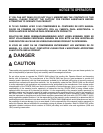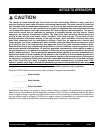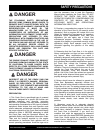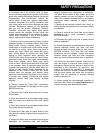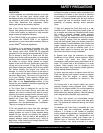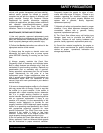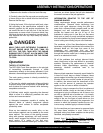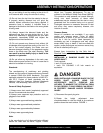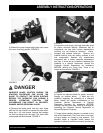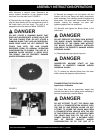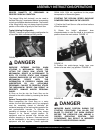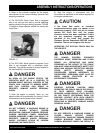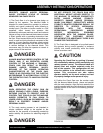
RCC130H-CRACK SAW OPERATION AND PARTS MANUAL REV #1 (11/18/04) PAGE 15
ASSEMBLY INSTRUCTIONS/OPERATIONS
1) Determine the location of the fuel tank filler cap.
2) Carefully clean the filler cap and surrounding area
to insure that no dirt or debris falls into the fuel tank.
Remove the filler cap.
3) Using the funnel, fill the fuel tank with fresh, clean
fuel according to the specifications outlined in the
material supplied by the engine manufacturer. Do
not overfill the tank or spill any fuel. If the fuel tank
incorporates a screen mesh to prevent debris from
falling into the tank, do not remove to increase the fill
rate. Replace the filler cap. Wipe away any excess
spilled fuel.
DANGER
MANY FUELS ARE EXTREMELY FLAMMABLE.
DO NOT SMOKE NEAR THE FUEL TANK. DO
NOT FILL THE FUEL TANK WITH THE ENGINE
RUNNING OR IF IT IS HOT. ALLOW AMPLE TIME
BETWEEN EACH REFUELING FOR THE ENGINE
TO COOL.
Operation
THEORY OF OPERATION.
The RCC130H Crack Saw operates on the principle
of transmitting horsepower through a V-Belt
transmission directly to an industry standard, 8 inch
diameter, diamond segment blade of various widths.
The crack sawing process is directly controlled by
these conditions:
a) The use of a suitable mechanism (diamond blade)
of proper design and configuration to penetrate the
work surface and remove material while delivering
acceptable service life.
b) Sufficient static weight supporting the diamond
blade to allow it to effectively penetrate the work
surface and remove material.
c) Adequate horsepower capable of rotating the
diamond blade at industry recognized speeds
against the work surface to deliver acceptable
productivity rates.
Since no two materials are exactly alike, no two
work surface materials can be sawed by the exact
same method. The nature of the sawing process,
along with operator experience, skill and common
sense, would suggest that efficient and productive
crack sawing is a matter of trial and error.
Combinations of diamond blade type, condition, and
feed rate are direct factors that will also determine
the overall success of the job application.
INFORMATION RELATIVE TO THE USE OF
DIAMOND BLADES.
Safety requirements always override performance
considerations. Diamond blade technology has
made such rapid advances during the past few
years that a diamond blade, properly used, on well
designed and well maintained equipment, can
provide the lowest cost per cut of any of the
methods of cutting now in use. But, put that same
blade onto a piece of poorly maintained equipment
and in the hands of a poorly trained operator and the
cost of cutting can virtually put you out of business.
The members of the Saw Manufacturer's Institute
have been a significant contributor to the state of the
diamond blade art. We hope that some of the
knowledge and experience that we have
accumulated in our many years in the business can,
through this booklet, assist you in keeping your cost
down to an absolute minimum.
Of all the problems that confront diamond blade
users, blade wear is the most difficult to accurately
evaluate. Reporting life performance of identical
diamond blade specifications operating under
seemingly identical conditions tend to be
inconsistent.
Masonry blade operators frequently report blade life
in terms of hours, days or weeks. However, these
reports neglect to mention type of material being cut,
the size of the cuts, and the number of cuts per day.
In addition, the amount and the cleanliness of the
water and the amount of pressure the operator
applies to the cut have an effect on blade life.
Obviously, trying to compare the life of one diamond
blade with another, simply on the basis of hours, is
analogous to trying to compare a set of tires on one
car with an identical set on another car...it is virtually
impossible. There are just too many variables...the
weight of the car, the types of roads driven on, the
condition of the car...particularly the suspension, the
manner in which the operator handles the car, etc.
Just as many variables apply to diamond blades.
So, the next time you have reason to compare blade
life, keep these variables in mind. Some of the
problems arising from these variables can be quickly
identified, and possibly corrected"...
Excerpt from: Rx for Diamond Blades, Problems,
Causes, Effects, Remedies, published by the
Masonry and Concrete Manufacturers Institute.



